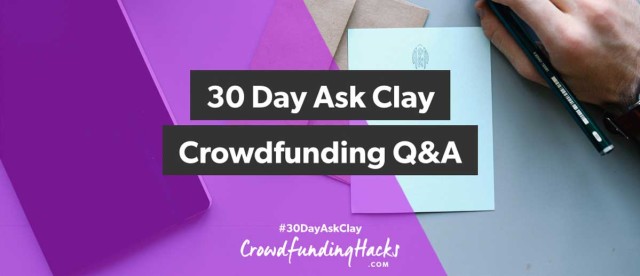This is the sixth post in our 30 Day Ask Clay Crowdfunding Q&A.
I’m answering a new question every day in June.
Submit your question by going to CrowdfundingHacks.com/AskClay, where you can see all of the questions and all of my answers.
Full Transcript
Hey everyone…this is Clay Hebert from CrowdfundingHacks.com…yesterday we talked about the rise of crowdfunding, and today’s question is…
What are some common misconceptions people have about crowdfunding?
Great question. There are actually quite a few.
Here are three of the biggest:
Misconception #1: There is actually a crowd
The first misconception is that there’s actually a crowd of strangers waiting to helping you reach your funding goal. There’s no secret crowd that gets together every Thursday night and decides which projects deserve to be funded or not. Crowdfunding is actually a lot of tiny micro-transactions and the “crowd” is often not assembled until you find and organize them (before you launch). Unless you’ve written a blog or newsletter and have built some form of permission to communicate with your tribe ahead of time, the “crowd” isn’t going to save you and fund your project. Which leads to…
Misconception #2: The crowdfunding platform (Kickstarter or Indiegogo) will bring me most of my traffic and backers
I see this all the time. The press highlights the outliers and celebrity projects raising millions and people think that, with no real marketing plan, Kickstarter or Indiegogo will bring them lots of traffic and backers. That’s not how it works.
Successful campaigns build good pre-launch permission (often via an email list) and typically bring the first 30-50% of traffic and backers themselves. Then, if it’s an interesting product, those first backers will share it. That “second circle” sharing gets you the next 20-30%. And then, if you’re 70-80% funded with enough time left, the platform will typically help you get the last 20-30%.
Misconception #3: A few big press hits (or a celebrity tweet) will bring me lots of traffic and backers
This belief is very common and understandable. And completely wrong. Press mentions from larger, more mainstream outlets are great for credibility. Definitely use that New York Times or Rolling Stone logo and grab a positive pull-quote or testimonial and put that on your landing page (before you launch) and on your crowdfunding campaign page (after you launch). But hits like this don’t typically drive a lot of traffic or backers. By definition, they’re “mainstream” so they appeal to a much broader audience than your campaign does.
What works better is smaller, more targeted press. I worked with Kittyo, a device for cat owners to see and play with their cat when the owner isn’t home. Kittyo was an innovative device and ended up getting a lot of press, but the campaign got more and better traffic from a popular but niche site called HausPanther.com, because HausPanther was exactly the Kittyo demographic (cat lovers who appreciated design). The tagline for HausPanther is “The premiere online magazine for design-conscious cat people”. Creators should focus less on the big names whose traffic doesn’t convert and find their HausPanther.
As always, you can submit your question or see all of the crowdfunding questions and my answers at http://crowdfundinghacks.com/AskClay
